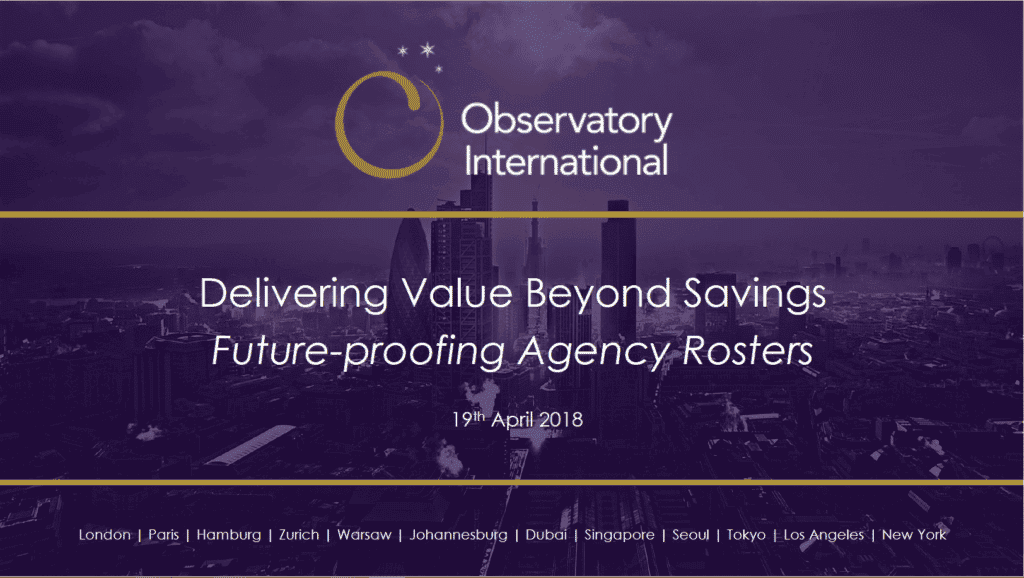Delivering Value Beyond Savings; Future-proofing Agency Rosters
ISBA’S COMPAG FORUM, 19th April 2018
Where does value lie? How can agency roster management help deliver outstanding creativity? Lucinda Peniston-Baines explains.
What do marketers want? Outstanding creativity, that’s what they want. Simple…
Except that all of us regularly encounter brand communications that are far from outstanding. So, the question is how does procurement help marketers deliver outstanding creativity?
My belief is that procurement’s role is here is to find ways to identify value beyond savings, marketers want quality and value-add not cost savings and the good news is that procurement can help deliver that.
Outstanding creativity is more likely to happen when marketers have access to a roster and structures that are designed for each company, that are bespoke to their state of readiness and business mission.
Too many brands have rosters that don’t fit their needs. Getting that right help ensure that marketers can focus on that all important creativity (without having to waste time managing agencies they don’t really need).
This requires procurement to go back to basics because fundamentally roster structure needs to be directed by the objectives and strategies that the business is pursuing.
The process is multi-stage and multi-input and will require collaboration and input from multiple parts of the business.
The first stage is to understand your business strategy. This should, by definition, be future-proofing you at an organisational level. You also need to be clear about your marketing operations strategy and develop a set of design principles to help you identify a better structure.
The second stage is to take a deep dive into the direction of your business. Ask your teams what’s going to grow your business and your sector. Is it geographical expansion, a better in-store experience or overall customer experience? Can you drive more revenue via e-commerce, premiumisation or mass personalisation, for example?
The third stage is to take a long hard look at yourselves. You need to understand existing ways of working and how your organisation is working with your agencies. This will allow you to identify any internal behaviours/organisational blocks. It will also help you understand what’s working well, what isn’t and why. An essential part of your role as procurement professionals, is to get an accurate fix on your current Agency costs so you can demonstrate cost implications.
All this information will allow you to define and refine your roster design principles. Torture test this vision against your design principles/evaluation criteria and get agreement at the most senior levels.
But even an agreed vision is only the first part of the process. You then need to develop strategies to operationalise what you want to achieve. What ways of working will you need, what governance is required, how will it deliver flexibility and agility as well as utilise existing tech and data. And do you have the right skills and capabilities to pull it off?
One area where many companies will be lacking is consumer insight. Insight will ensure your roster is customer-centric and insight driven, creating a virtuous loop that continuously learns and informs strategy.
Better insight is probably the best way of delivering added value. It helps better inform strategy, delivers improved competitive advantage and ensures that more relevant (and fewer) of the right assets will be created at right time, reducing downstream production costs. Of course, depending on the maturity of your organisation’s Insight function, this may require investment initially.
It’s vital to remember not to be a trend chaser. Don’t adopt a roster model simply because it’s getting lots of coverage in the trade press. Remember that the right roster model for your organisation will be bespoke and potentially hybrid.
As ever, it must also be backed by a clear measurement strategy. Any new roster model must be monitored and measured on how well it is delivering against its KPIs, demonstrating value beyond savings.
This can be a mix of hard and soft value measures such as brand consistency, quality/uptake of assets and Integration of outputs. It could focus on outcomes such as customer engagement or brand consideration. It should also include assessment of rostered agency performance potentially including, for example, increased speed to market and right first-time responses to brief.
All this work, however, will only maximise dividends if your organisation is also future-fit. Even the right roster won’t transform a company that lacks the internal skills and capability to deliver on the promise of a brilliant roster structure.















